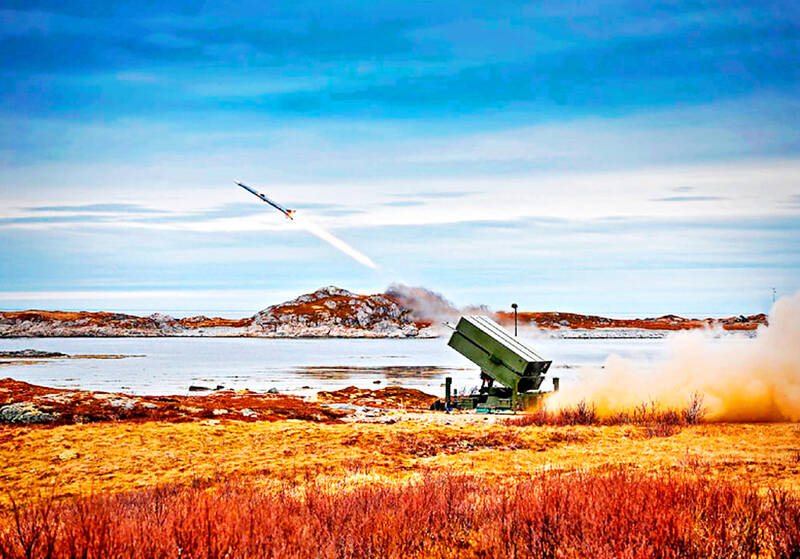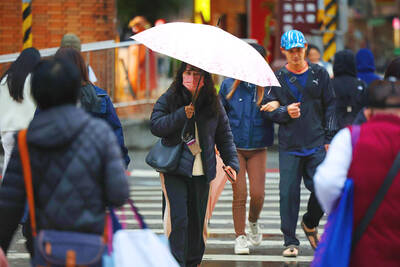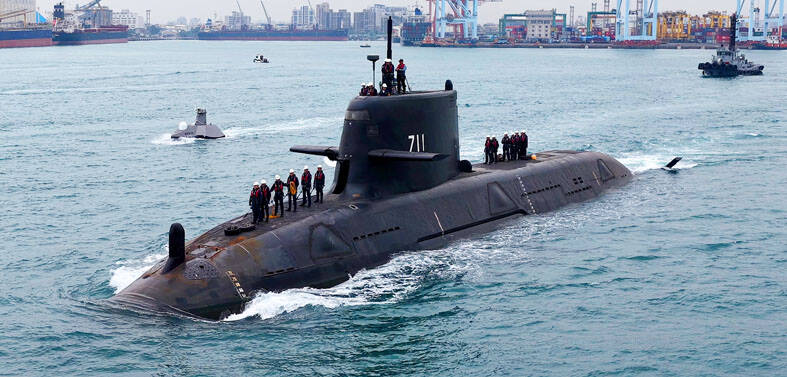The US’ approval of exports of three advanced air defense missile systems to Taiwan signified NATO’s goodwill toward the nation, a Taiwanese defense expert said.
The US Defense Security Cooperation Agency on Friday announced the US$1.16 billion sale of the National Advanced Surface-to-Air Missile System (NASAMS) and the US$828 million sale of AN/TPS-77 and AN/TPS-78 radar turnkey systems.
The NASAMS is a network that uses ground-launched Air Intercept Missile (AIM)-120 Advanced Medium-Range Air-to-Air Missiles (AMRAAM) to intercept hostile aircraft, drones and cruise missiles.

Photo: Screen grab from Kongsberg Defence and Aerospace’s Web site
Su Tzu-yun (蘇紫雲), director of defense strategy and resources at the state-funded Institute for National Defense and Security Research, said that Taiwanese first expressed interest in the NASAMS to their US counterparts in 2022.
The US could not transfer an air defense system it designed in partnership with Norway without the Scandinavian country’s permission, and by extension, NATO, he said on Saturday, adding that the acquisition of the systems significantly boosts Taiwan’s defense capabilities.
The NASAMS can detect aerial objects at 300km, engage targets at 40km to 60km, and include counter jamming capabilities, he said.
The mobile systems provide defensive firepower for strategically important installations, he said, adding that their ability to use AIM-120 and AIM-9 missiles significantly increases the military’s defensive capabilities.
More weapons such as NASAMS dedicated to defeating medium and low-altitude targets are needed to defend strategic installations after China demonstrated its capability to deploy up to six vertical launching system-equipped warships in waters around Taiwan, he said.
The NASAMS represent the first asymmetric-warfare-capable systems furnished by US President Joe Biden, defense expert Mei Fu-hsing (梅復興) said, adding that each system is a self-contained unit composed of a fire control center, radar and launchers.
The systems can be operated by company-sized units, he said.
The radar turnkey and missile systems would likely bolster Taiwan’s ability to defend Taipei by detecting threats posed by stealth fighters and drones, military experts said.
The AN/TPS-77 radar system, which has a range of 470km, is used for long-range air surveillance and is especially good at detecting small aerial objects, Institute for National Defense and Security Research associate research fellow Shu Hsiao-huang (舒孝煌) said.
The AN/TPS-78 radar system has an instrumental range of 444km and can better identify low-altitude cruise missiles and drones, he said.
Retired air force officer Chou Yu-ping (周宇平) said the surface-to-air missile systems would be deployed in Taipei to guard the capital against cruise missiles and fighter jets.
Sharing the intelligence gathered by the AN/MPQ-64F1 Sentinel radar systems equipped on the surface-to-air missile systems with the air force’s integrated network would be crucial, Chou said.
The missile systems in the newly disclosed sales are expected to replace the HAWK surface-to-air missile system, which covers medium-range and low-to-medium altitude objects in Taiwan’s air defense, Shu said.
The Sentinel radar systems can identify targets within a range of 120km, and the shooting range of the 123 AMRAAM is 50km, he said.
The new missile systems can be used to launch several types of missiles, such as the AIM-120 and AIM-9X models which are made by same manufacturer, as well as the IRIS-T medium range infrared homing missiles, he said.
If the missile systems can also be deployed with the indigenous Tien Chien I (天劍一, “Sky Sword 1”) and Tien Chien II (天劍二, “Sky Sword II”) missiles, that would further improve the country’s defense independence, he said.
Commenting on a reported plan to retire the air force’s 35mm and 20mm anti-aircraft twin cannons, Shu said they should remain in service, as it is not cost-effective to use missiles to shoot down uncrewed flying objects.

US climber Alex Honnold is to attempt to scale Taipei 101 without a rope and harness in a live Netflix special on Jan. 24, the streaming platform announced on Wednesday. Accounting for the time difference, the two-hour broadcast of Honnold’s climb, called Skyscraper Live, is to air on Jan. 23 in the US, Netflix said in a statement. Honnold, 40, was the first person ever to free solo climb the 900m El Capitan rock formation in Yosemite National Park — a feat that was recorded and later made into the 2018 documentary film Free Solo. Netflix previewed Skyscraper Live in October, after videos

NUMBERS IMBALANCE: More than 4 million Taiwanese have visited China this year, while only about half a million Chinese have visited here Beijing has yet to respond to Taiwan’s requests for negotiation over matters related to the recovery of cross-strait tourism, the Tourism Administration said yesterday. Taiwan’s tourism authority issued the statement after Chinese-language daily the China Times reported yesterday that the government’s policy of banning group tours to China does not stop Taiwanese from visiting the country. As of October, more than 4.2 million had traveled to China this year, exceeding last year. Beijing estimated the number of Taiwanese tourists in China could reach 4.5 million this year. By contrast, only 500,000 Chinese tourists are expected in Taiwan, the report said. The report

Temperatures are forecast to drop steadily as a continental cold air mass moves across Taiwan, with some areas also likely to see heavy rainfall, the Central Weather Administration (CWA) said. From today through early tomorrow, a cold air mass would keep temperatures low across central and northern Taiwan, and the eastern half of Taiwan proper, with isolated brief showers forecast along Keelung’s north coast, Taipei and New Taipei City’s mountainous areas and eastern Taiwan, it said. Lows of 11°C to 15°C are forecast in central and northern Taiwan, Yilan County, and the outlying Kinmen and Lienchiang (Matsu) counties, and 14°C to 17°C

STEERING FAILURE: The first boat of its class is experiencing teething issues as it readies for acceptance by the navy, according to a recent story about rudder failure The Hai Kun (海鯤), the nation’s first locally built submarine, allegedly suffered a total failure of stern hydraulic systems during the second round of sea acceptance trials on June 26, and sailors were forced to manually operate the X-rudder to turn the submarine and return to port, news Web site Mirror Daily reported yesterday. The report said that tugboats following the Hai Kun assisted the submarine in avoiding collisions with other ships due to the X-rudder malfunctioning. At the time of the report, the submarine had completed its trials and was scheduled to begin diving and surfacing tests in shallow areas. The X-rudder,